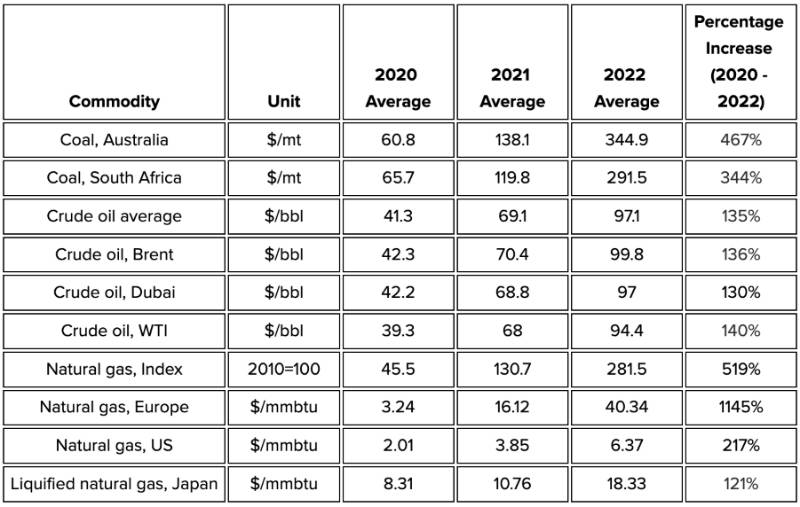Build Your Own Portfolio: How 2 expert investors would spread $10k across ASX oil and gas stocks

Picture: Getty Images
Oil and gas prices have seen significant gains since the COVID 19 pandemic with natural gas prices in Europe seeing a massive 1,145% gain from 2020 to 2022 mainly due to the Russian invasion of Ukraine.
The scramble for gas also resulted in countries looking for alternatives, going so far as to bring mothballed coal power plants back online.
Unsurprisingly, prices of all fossil fuels rose during the same period with City Index showing that Australian coal climbed 467% during the same period while the benchmark Brent crude rose 136%.

Despite this growth, analysts speaking to Stockhead believe the Australian oil and gas sector is likely to face challenges and opportunities with Peak Asset Management portfolio manager Louis Varrasso saying that influencing factors include global commodity prices and regulatory policies as well as demand and supply dynamics.
He noted that oil prices had fallen last month towards the US$70 per barrel mark – the lowest in 15 months – on concerns that rising cost pressures and a global banking crisis would hit demand.
“Still, further action by OPEC+ aimed at supporting the stability of the oil market was not expected and as a result of intervention saw the price of crude trade up to 8% higher when trade recommenced,” Varrasso added.
Shaw and Partners senior investment adviser Adam Dawes added that was interesting how OPEC+ seemed to be another central bank that could lift or decrease inflation albeit on the oil price.
“There’s obviously a lot of quotes going around that oil’s going to get to US$100 a barrel but overall, OPEC controls the output so they will definitely be able to make sure that they get it right and get the product mix right. I think it is definitely transformative,” Dawes noted.
Technology and producers
Looking into the near-future, Varrasso said that advancements in technology, such as hydraulic fracturing and horizontal drilling, have enabled oil and gas companies to extract resources from previously inaccessible areas.
“These technological innovations could lead to increased production and profitability in the sector,” he added.
“I think we will see a lot of overlooked or previously drilled assets revisited in the coming 12 months as OPEC have demonstrated a proactive approach to stabilising the oil price.”
Looking further into the future, Dawes pointed out that lots of the big majors were basically saying that they were going to become cash boxes that run down their assets.
“It will be quite interesting to see how these energy plays can still maintain their market share by 2030 or 2050, but then also be net zero or be businesses that are not going to be polluting the atmosphere, and that’s going to be really difficult,” he added.
“We have started to see some energy companies looking around and going how are we going to become net zero by that. The energy sector is definitely going to change, it can’t continue the way it is.”
Buying into oil and gas
So how can investors best buy into the oil and gas sector?
Dawes reckons that with the current energy renaissance, investors were best off looking at producers as they are the companies that would make all the money.
“You always have to look at producers because if there’s no new products, no new stream of products coming on, then only the ones that have oil or gas in the ground can be profitable,” he explained.
He pointed to supermajor Shell posting its highest ever annual profit in 2022, saying that producers were reaping the benefits of being in production.
“Some of the explorers are going to struggle until they can get gas out of the ground, but then they’re going to be held to this net zero standard, which everyone’s going have to do,” Dawes added.
“It’s definitely going to be changing the landscape of the market and the way one, people look at shares, and two, oil used to be the engine of growth for the world but now it’s probably not going to be that.”
On the assumption that with a hypothetical $10,000 to build an oil and gas portfolio with, Dawes said Shaw and Partners would always stick with quality and that in Australia it was hard to go past Woodside (ASX:WDS) and Santos (ASX:STO).
“There are our two top picks, but if I had to pick one of those with $10,000, it would be Santos because it is higher-geared to the oil price. So as the oil price goes higher, Santos goes higher,” he opined.
“Santos has some PNG assets which they might look to sell down one day whereas Woodside has just bought very large assets.
“But both are very good companies. Woodside is better on the dividends for clients. It would be those two that I’d be picking for investors that want to get access to oil.”
For investors with more appetite for risk, Dawes reckons that Karoon Energy (ASX:KAR) is a good option with some near-term positives while engineering firm Worley (ASX:WOR), which builds oil and gas infrastructure is another option as they are also looking to transform the business over the next three to five years into a green engineering business for solar and wind farms.
“That’s a really good way of getting some oil and gas access via the engineering side but also getting the tailwind of that green energy that needs to be built,” Dawes said.
“And trillions of dollars needs to be spent each year to get us to that net zero 2050.”
Varrasso takes a more balanced approach with his $10,000, saying an ideal portfolio would includes a mix of energy stocks such Bass Oil (ASX:BAS) and Metgasco (ASX:MEL) as well as a staple producer to balance things out.
“Bass Oil managing director Tino Guglielmo has continued to deliver on the vigorous road to mid-tier oil & gas company – strategy, publishing strong revenue growth in FY22 and a net profit after tax of $42,593, only the second NPAT in the last five years,” he explained.
“Bass produced 124,501 barrels of oil (net) during 2022, up 54% from the previous year. Their burgeoning growth potential expanding through increasing production and high-impact gas plays, in particular, via the deep Permian coal gas project in Bass’ 100% owned PEL 182 and testing the Kiwi gas discovery.
“However, our excitement is contained within Bass’ (100% interest) of PEL 182 in the Cooper Basin, South Australia, which has the potential to host 21 trillion cubic feet of in place gas along with 845 million barrels of condensate/oil in the deep coals.
“Santos has recently drilled and plans to frac the Beanbush 3 horizontal well to test commercialisation potential of the coals adjacent to PEL 182, in the same geological setting.”
He added Metgasco has interests in several assets across Western Australia, including the Cooper Basin and the Perth Basin and is now supplying gas from the Vali-1 and Vali-3 wells within the ATP 2021 joint venture (MEL 25%).
“The Vali joint venture has refrained from contracting the bulk of the field’s gas reserves, to enable a thorough understanding of the field’s producing reservoirs from its three existing wells,” Varrasso noted.
“The understanding acquired over the first 6–9 months of production will inform the preparation of a full field development plan and marketing of Vali’s uncontracted gas, which currently stands at gross 85 petajoules (Metgasco 21.25PJ).
“The Odin gas field located about 7km west of Vali has been independently certified as containing a gross 2C resource of approximately 40PJ of gas (Metgasco 10PJ). Metgasco can deliver significant value by leveraging its uncontracted reserves and resources into a growing East Coast market.”
Related Topics

UNLOCK INSIGHTS
Discover the untold stories of emerging ASX stocks.
Daily news and expert analysis, it's free to subscribe.
By proceeding, you confirm you understand that we handle personal information in accordance with our Privacy Policy.








